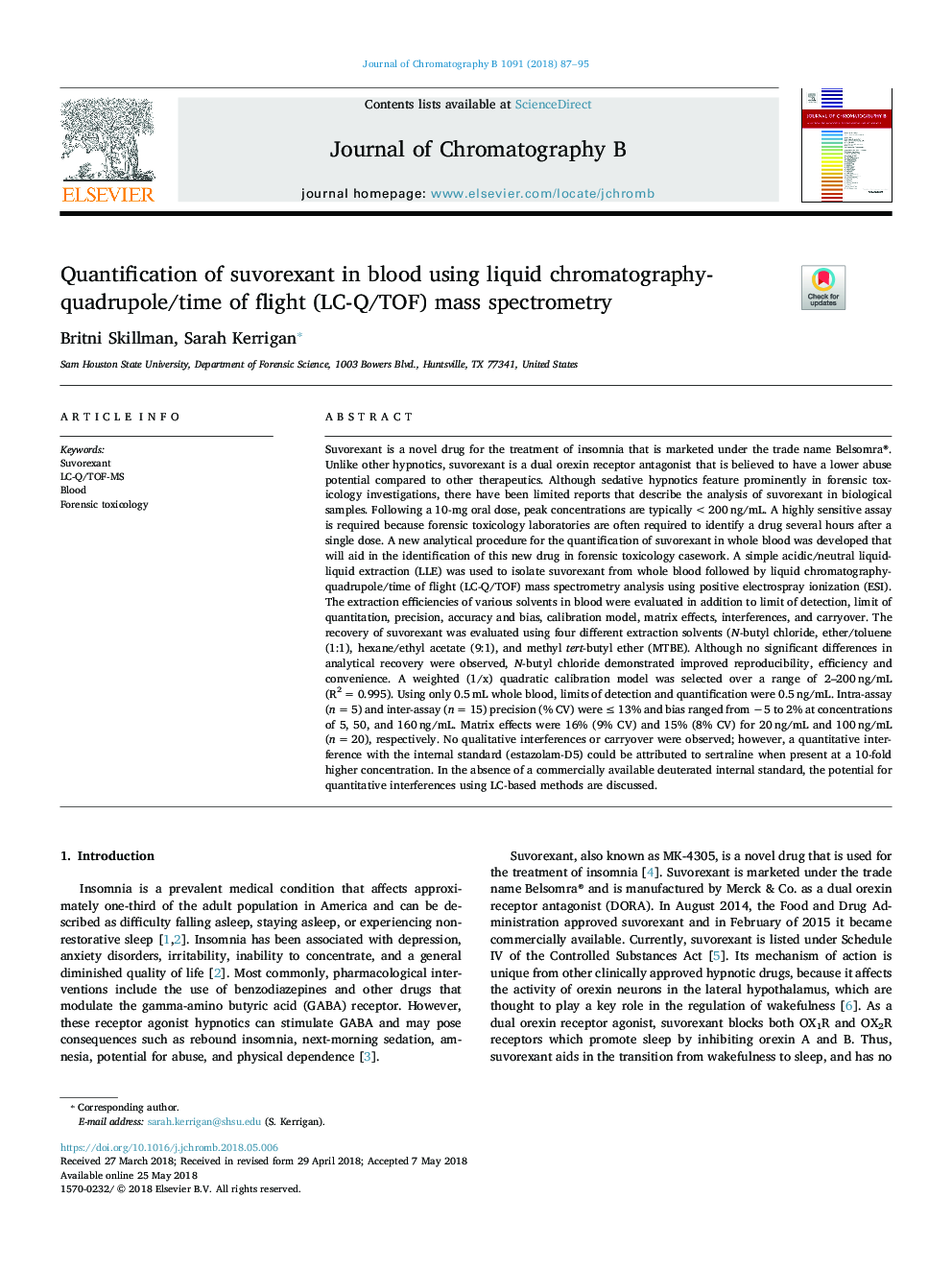| کد مقاله | کد نشریه | سال انتشار | مقاله انگلیسی | نسخه تمام متن |
|---|---|---|---|---|
| 7614907 | 1493979 | 2018 | 9 صفحه PDF | دانلود رایگان |
عنوان انگلیسی مقاله ISI
Quantification of suvorexant in blood using liquid chromatography-quadrupole/time of flight (LC-Q/TOF) mass spectrometry
دانلود مقاله + سفارش ترجمه
دانلود مقاله ISI انگلیسی
رایگان برای ایرانیان
موضوعات مرتبط
مهندسی و علوم پایه
شیمی
شیمی آنالیزی یا شیمی تجزیه
پیش نمایش صفحه اول مقاله

چکیده انگلیسی
Suvorexant is a novel drug for the treatment of insomnia that is marketed under the trade name Belsomra®. Unlike other hypnotics, suvorexant is a dual orexin receptor antagonist that is believed to have a lower abuse potential compared to other therapeutics. Although sedative hypnotics feature prominently in forensic toxicology investigations, there have been limited reports that describe the analysis of suvorexant in biological samples. Following a 10-mg oral dose, peak concentrations are typically <200â¯ng/mL. A highly sensitive assay is required because forensic toxicology laboratories are often required to identify a drug several hours after a single dose. A new analytical procedure for the quantification of suvorexant in whole blood was developed that will aid in the identification of this new drug in forensic toxicology casework. A simple acidic/neutral liquid-liquid extraction (LLE) was used to isolate suvorexant from whole blood followed by liquid chromatography-quadrupole/time of flight (LC-Q/TOF) mass spectrometry analysis using positive electrospray ionization (ESI). The extraction efficiencies of various solvents in blood were evaluated in addition to limit of detection, limit of quantitation, precision, accuracy and bias, calibration model, matrix effects, interferences, and carryover. The recovery of suvorexant was evaluated using four different extraction solvents (N-butyl chloride, ether/toluene (1:1), hexane/ethyl acetate (9:1), and methyl tert-butyl ether (MTBE). Although no significant differences in analytical recovery were observed, N-butyl chloride demonstrated improved reproducibility, efficiency and convenience. A weighted (1/x) quadratic calibration model was selected over a range of 2-200â¯ng/mL (R2â¯=â¯0.995). Using only 0.5â¯mL whole blood, limits of detection and quantification were 0.5â¯ng/mL. Intra-assay (nâ¯=â¯5) and inter-assay (nâ¯=â¯15) precision (% CV) wereâ¯â¤â¯13% and bias ranged from â5 to 2% at concentrations of 5, 50, and 160â¯ng/mL. Matrix effects were 16% (9% CV) and 15% (8% CV) for 20â¯ng/mL and 100â¯ng/mL (nâ¯=â¯20), respectively. No qualitative interferences or carryover were observed; however, a quantitative interference with the internal standard (estazolam-D5) could be attributed to sertraline when present at a 10-fold higher concentration. In the absence of a commercially available deuterated internal standard, the potential for quantitative interferences using LC-based methods are discussed.
ناشر
Database: Elsevier - ScienceDirect (ساینس دایرکت)
Journal: Journal of Chromatography B - Volume 1091, 1 August 2018, Pages 87-95
Journal: Journal of Chromatography B - Volume 1091, 1 August 2018, Pages 87-95
نویسندگان
Britni Skillman, Sarah Kerrigan,